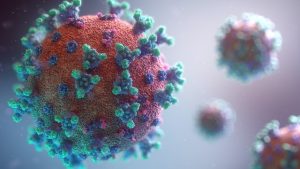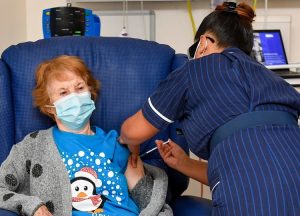15th January 2021 – The emergence of three new coronavirus variants have made the pandemic more dangerous. We explain why, what this means for all of us and how the problem can be defeated.
A Blog by Dr David J Flavell PhD FRCPath & Dr Sopsamorn (Bee) Flavell BSc PhD
Scientific Directors of Leukaemia Busters
15th January 2021
Virus Variants & Vaccines
The tragic cost in human lives of the coronavirus pandemic continues at an accelerated rate as infections continue to rip through the population. It’s no exaggeration to say that the emergence of new COVID-19 mutant virus (SARS-CoV-2) variants makes the pandemic much more difficult to deal with. It introduces increased dangers simply because the new variants can be transmitted from person to person that much easier. This blog is intended to explain exactly why this is the case, how this might possibly affect vaccine efficacy and if so what can be done to overcome such problems.
The first thing to understand is that there are already several hundred different mutant variants of the COVID-19 virus already in circulation throughout the world. In the vast majority, the types of mutations have absolutely no effect on the way in which the virus behaves, it remains unchanged.
In contrast some mutations such as the ones described in the UK, South Africa and most recently Brazil varieties cause real changes to the way in which the virus behaves. These are the potentially dangerous ones to look out for if such mutations have the effect of making the virus more infectious, more virulent (i.e. cause more severe disease) or change the viral protein structure so that vaccines no longer work against it.
So why is it that some mutations are harmless whilst others change the virus to make it more dangerous? Firstly you need to understand exactly what a mutation is and how they arise in the virus. Let us stress that it is not the popularised mutant creatures seen in many horror movies but rather it is the blind chance process that drives evolution in all living organisms (that includes viruses which are not strictly alive) making them fitter and subsequently more successful at spreading and surviving.

Computer generated illustration of a Covid-19 virus
What is a Mutation?
In simple terms mutations in the virus arise in the following way. The virus has genetic material comprised of RNA that contains the code for the four major proteins that make up the viruses structure. The individual building blocks of each individual protein are amino acids (there are 20 different amino acids) and each is encoded by a three letter code termed the codon. Each codon is made up from chemicals called nucleotide bases that form part of the viral RNA. You can visualise the long RNA molecule as being similar to an old fashioned tape recorder with the three letter codons strung out along the length of the tape that is read off in sequence to build each protein into a chain-like structure using the combination of amino acids that are coded for on the tape.
How do mutations arise in the Virus?
Each time the virus replicates inside the host cell it is infecting it hijacks the molecular machinery of that host cell to duplicate its own RNA that is then included in the next generation of viral particles produced. This duplication process is naturally prone to errors and occasionally the letters in the viruses RNA that make up the code to make the protein are changed slightly. It is these letter changes that are referred to as mutations, a process that is driven purely by chance. Once a mutation occurs that is favourable to the viruses spread and survival then this gives that particular new strain an advantage over its predecessors and it spreads more readily in the host population becoming the dominant strain. This is exactly what is happening with the new UK, South African and Brazilian strains now in circulation in we humans.
Mutations are to be Expected
The vast majority of mutations have little or no effect on the structure of the viral proteins but occasionally one or more can alter the shape of the protein in such a way that it takes on new properties that may benefit the viruses propagation and spread from individual to individual. In other words the virus has become more successful in its own and its progeny’s quest for survival. Currently there have been around 4,000 mutations detected in the spike protein of the SARS-CoV-2 virus worldwide but the majority have little or no effect on changing the viruses behaviour.
The spike (S) protein is arguably the most important viral protein because this is the protein that the virus uses to latch on to our cells to infect them via a receptor called ACE2 found on the surface of many human cell types including those lining the airways and lungs.
The New SARS-Cov-2 Variants
What has happened in the case of the new more contagious UK variant (which belongs to the so called B.1.1.7 lineage also called VOC -202012/01), first detected in Kent in September 2020, is that seventeen mutations have occurred in the spike protein with just one of these slightly changing the structure of the most vital part called the receptor binding domain (RBD). This particular variant has a mutation called N501Y that has had the effect of making the virus attach more strongly to human cells therefore making it significantly more infectious; current estimates suggest by at least 58%. Currently, there seems to be no evidence that the N501Y mutation causes more severe illness or an increased risk of death.
Why are the New Strains so Concerning?
The South African (B.1.351 lineage) and Brazilian (B.1.1.248 lineage) variants you have probably heard about recently also have the same N501Y mutation but they also have additional mutations called K417N & E484K that occur in the same critical RBD part of the spike protein making them viral strains of concern. The E484K mutation is one that scientists are particularly concerned about because this is in a region of the RBD that a number of antibodies seem to recognize.
The E484K mutation has been shown to reduce antibody recognition, helping the virus to bypass immune protection provided by prior infection or vaccination. These variants also appear to spread more easily and more quickly than other variants. There is currently no evidence to suggest that these variants cause more severe illness or increased risk of death but they are important because of their increased infectivity and the possibility that they might allow the virus to evade the effectiveness of current vaccines. The jury is still out on this all important issue and lab based work is frantically underway right now to answer this question.
What’s to be Done?
So what might all this mean for the way in which the pandemic plays out in future?
Now that we know the new variants are more infectious than the original strain of coronavirus this means that more than ever we have to exercise great caution in our daily lives and do the following:
- Scrupulous hand washing/sanitising whenever things outside the home have been touched or handled.
- Clean objects and surfaces you touch often (such as door handles, kettles and phones) using your regular cleaning products.
- Mask wearing in ALL public spaces (including in the open air) by EVERYONE will be essential to reduce transmission of the new variants as will strict social distancing. Always wash a reusable mask after every use.
- Accept that severely limiting our social contacts over the next few months is the only realistic way to bring the epidemic back under control at least until there are sufficient numbers of vaccinated people in the community.
- In addition we also recommend the sanitisation of everything coming into the home from outside, shopping, mail, newspapers, parcels and in particularly shoes worn outside all need a quick wipe down with warm soapy water or bleach diluted in water to ensure that they are free of contaminating virus. We take this to an extreme and bake all our mail and newspapers at 100oC for 10 minutes to ensure destruction of any contaminating virus particles.
We and many of our neighbours and friends have been doing this since March of last year and although it is tedious and time consuming and some might say is over-zealous, we believe it to be an important way of ensuring that coronavirus isn’t inadvertently imported into your home.
Fomites, as they are so called, are any inanimate object contaminated with viruses lying on their surface where they can survive for days or even weeks waiting for the opportunity to transfer and infect some unsuspecting individual who happens to touch and transfer virus to their face. There is absolutely no harm in being over-zealous if it means that you reduce the risk of infection to yourself, family and other people to an absolute minimum.
Will the Vaccines still work?

Dec 8, 2020 Margaret Keenan (L) said, "I feel so privileged to be the first person vaccinated against COVID-19, it's the best early 91st birthday present".
You’ve probably seen that there has been concern voiced in the popular and scientific press that the current vaccines might be ineffective against the viral UK variant we are now living with. But there is some good news to be had here! Some very recent lab data indicates that current three COVID-19 vaccines (Pfizer-BioNTech, Oxford-AstraZeneca & Moderna) will still be effective against the UK variant that have emerged so far, whilst it is still too early to tell whether the current vaccines will be effective against the South African and Brazilian variants.
We say “so far” because this is far from the end of the story. The plain fact is that the more people who become infected with the COVID-19 virus the more mutations will occur increasing the probability that variants resistant to existing vaccines will arise. This is just something that has to be factored into our fight against the virus and is yet another very good reason why we should do everything in our power to reduce the number of people infected globally as quickly as possible by strictly following all the measures to reduce transmission rates.
If a vaccine resistant strain does arise this is something we can deal with because of the amazing technology we now have available at our fingertips. Once we know the nature of the mutation, easily determined these days in the lab by something called NGS (stands for Next Generation Sequencing) then this allows any vaccine to be redesigned to accommodate the new mutation.
Vaccine redesign is quite easy for the RNA-based vaccines and less so for the Oxford-AstraZeneca vaccine but still doable. Of course we all hope that this can be avoided and that the existing vaccines continue to work effectively. Bear in mind that it’s not just a simple case of just redesigning the vaccine, it’s the safety evaluation, manufacture, distribution and administration of any new vaccine that replaces the old and that is going to take time, money and a cost in human lives as we wait for it to become available, though this should in theory prove to be a quicker process than for the first vaccine.
For now let us remain optimistic that a vaccine redesign never becomes necessary while pushing ahead with a global vaccination programme using the one we already have. We personally feel confident that one day in the not too distant future this will all be over but until then it’s vital that we all continue to practice those mitigation methods of hand washing, face mask use and strict social distancing measures to get that all important R value down as quickly as possible in order to buy precious time that returns the entire human race back to some normality.
A Free High Spec Washable Face Mask for You!

We have obtained specific funding for a supply of high quality reusable/washable 4-layer face masks that we are offering to people in limited numbers for free.
To claim your mask please do all of the following things:
- Email contact@leukaemiabusters.org.uk using the wording “Mask Request” in the subject heading.
- Give your name, address and telephone number in the body of the email.
- State whether you require 1 or 2 masks.
- Send a £1.29 stamped self addressed envelope using large C5 size envelope (162 x 229 mm) to Leukaemia Busters, MP3, Southampton General Hospital, Southampton SO16 6YD or send a cheque payable to Leukaemia Busters for the postage cost.
Please note a maximum of two masks per request. Allow up to a week for delivery from when we receive your stamped self addressed envelope.We will not retain your personal details without your permission other than for the purpose of mailing your face mask to you. We do not have the resources to be able to reply to everyone who might apply so if you do not hear from us it means that the full quota of masks has been used up.
Whilst we are offering face masks free of charge, if you feel able, a small donation to Leukaemia Busters would be much appreciated. Click here to make a donation
Note: None of Leukaemia Busters research funds have been used in the supply of these masks.
To read our other blogs click here.
For an up to date on our COVID-19 blog please follow us on Twitter:
Please like us on Facebook.


